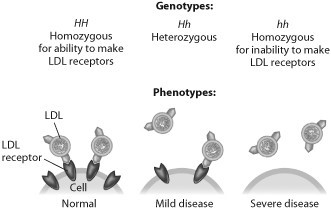According to this figure, heterozygotes for this form of hypercholesterolemia suffer from the disease because they

A) produce an abnormally shaped LDL receptor.
B) don't produce any LDL receptors.
C) produce too many LDL receptors.
D) don't produce enough LDL receptors.
Answer: D
You might also like to view...
How does the ear allow humans to distinguish the volume of different sounds?
A) Louder sounds cause larger action potentials than do softer sounds. B) Louder sounds cause smaller action potentials than do softer sounds. C) Louder sounds induce a higher frequency of action potentials than do softer sounds. D) Louder sounds induce a lower frequency of action potentials than do softer sounds. E) Louder sounds cause larger action potentials than do softer sounds, and louder sounds induce a higher frequency of action potentials than do softer sounds.
Based on the phylogenetic tree shown, which of the following is a correct statement of evolutionary relationships?
A. A snake is equally related to a bird and a crocodile. B. A snake is more closely related to a crocodile than to a turtle. C. A snake is more closely related to a crocodile than to a bird. D. A snake is more closely related to a bird than to a crocodile. E. A snake is more closely related to a frog than to a human.
Glucosylation of hydroxymethylcytosine residues protects phage T4 DNA from cleavage by bacterial restriction enzymes.
Answer the following statement true (T) or false (F)
Describe the different types of microbial competition and the role of microbial metabolites in mediating those interactions.
What will be an ideal response?